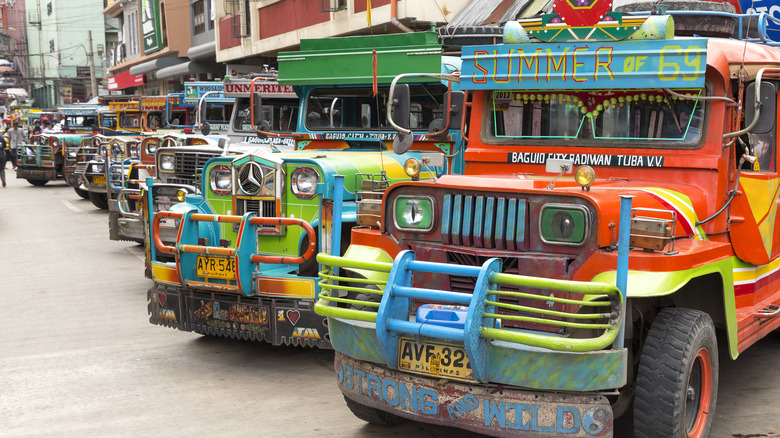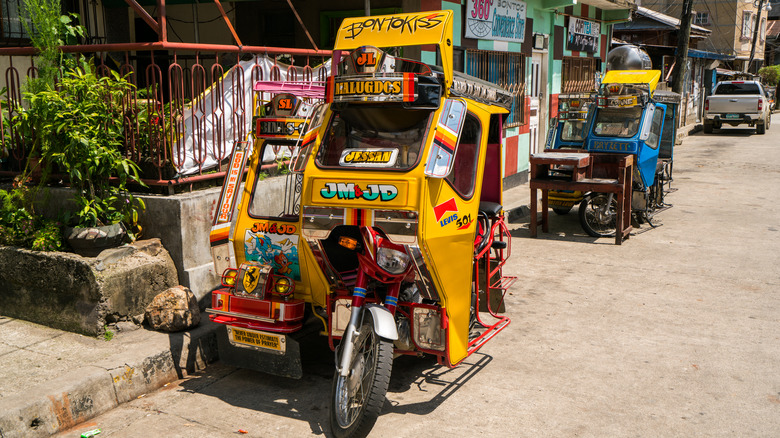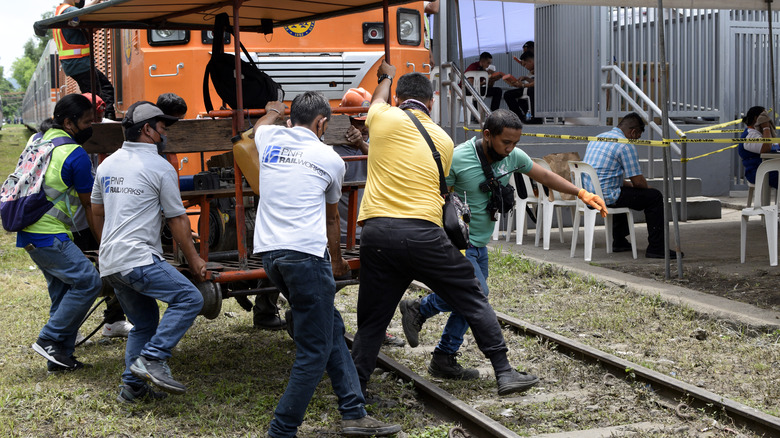Don't Skip The Unique, Quirky Forms Of Public Transportation In This Asian Island Country
Knowing how to get around a destination is important for practical reasons. But sometimes, the local modes of transportation are just as much of an experience as a place's attractions and famous sites. There are the iconic (and expensive) yellow cabs in NYC, the tuk-tuks in Thailand, and the charming streetcars in cities like Lisbon, Portugal.
The Philippines, too, has some unique and delightful ways of getting around that you won't want to miss when visiting the Asian country. One of the easiest to spot is the jeepney, a taxi that looks like a cross between a truncated school bus and a heavy-duty jeep. However, what makes these vehicles so eye-catching are their brightly decorated exteriors, emblazoned with boldly painted images, graffiti-style text, and other designs.
Jeepneys were first introduced to Philippine cities in the 1950s after locals reconstructed military vehicles left behind by the U.S. Now, you can find the taxis hauling large groups of passengers — up to 30 can squeeze inside and on top of the roof. To take a ride in a jeepney, wave to get the driver's attention, or wait in a designated terminal until one pulls up.
Tricycles are another quirky way to get around
A tricycle might sound like something you haven't ridden since you were a toddler, but in the Philippines, the term "tricycle" has an entirely different meaning. If you're in a city like Cebu or Manila, a tricycle is a motorcycle with an attached sidecar used for carrying passengers. Like jeepneys, tricycles are sometimes spruced up with colorful motifs and designs, though you might find more minimalistic versions as well.
It's not unusual to see several people crammed into one sidecar, but note that tricycles offer much less space than jeepneys, making them more ideal for quick hop-on, hop-off trips than long journeys. Also be aware that while the sidecars come with a roof, the sides are often left open, so a tricycle might not be the best choice during the rainy season (one of the most budget-friendly times of year to visit the Philippines).
When the skies are clear, however, a ride in a tricycle is a must during your trip to the Asian island country. Head near a main road to find a tricyclist waiting for passengers or flag a driver down if you notice an empty sidecar. Then, confirm your destination and the fare before hopping inside.
Public transportation differs in and outside of cities
The types of transportation available during your trip to the Philippines can vary depending on where you travel. For instance, you'll find familiar modes in the country's big cities, from traditional taxis to buses and even metro trains. If you're accustomed to using ride-sharing apps like Uber, note that similar services are available in the cities of the Philippines, though Grab — not Uber or Lyft — dominates the local ride-hailing scene. Also, don't be surprised if a motorcycle comes to pick you up instead of a car or SUV.
In remote destinations and smaller villages, you'll likely find a number of man-powered vehicles in place of motorized ones. Pedicabs are common and can be thought of as a pared-down tricycle, where a cyclist pedals a bike with a sidecar attached. On railroads (both in and outside of the metropolitan districts), you may also find people powering passenger trolleys between trains. Although these trolleys are popular among locals, they can be dangerous, as the trolley drivers must know when trains are scheduled to come so they can remove their carts from the tracks. Unless you consider yourself a risk-taker, you might want to skip this form of public transportation.


